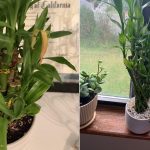Are Bromeliads Toxic To Cats? Delve into the facts to discover whether they are a safe or an unhealthy combo!
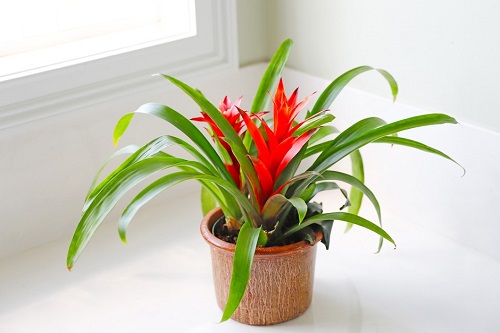
Ever spotted your feline friend eyeing your bromeliad plant and wondered, Is this safe? You’re not alone. We all want a safe haven for our whiskered companions. So here we pick one of the most discussed topics—Are Bromeliads Toxic To Cats?
Check Out These Deadly but Beautiful Poisonous Flowers that Attract And Repel You At The Same Time!
What Are Bromeliads?
Bromeliads are vibrant tropical plants that belong to the Bromeliaceae family. They are native to South America and are known for their appealing appearance. Boasting over 3,000 diverse species that vary in shape, size, and color, these versatile plants are a popular choice for indoor decoration. Their low-maintenance nature, adaptability to various lighting conditions, and exotic flair make them a common sight in both homes and offices.
Are Bromeliads Toxic To Cats?

You may breathe a sigh of relief! Bromeliads are not toxic to cats.
If your mischievous feline happens to nibble on one, it isn’t likely to be a poisoning concern, as bromeliads count under the list of pet-safe plants by ASPCA. However, non-toxic doesn’t automatically spell out completely safe. Although rare, some cats may have an adverse reaction to the plant, which could result in mild symptoms like vomiting or diarrhea. This isn’t a sign of toxicity but rather a sensitivity to foreign substances. The best action is to discourage cats from chewing on bromeliads and consult a veterinarian if any unusual symptoms appear.
Why Do Cats Chew on Plants?
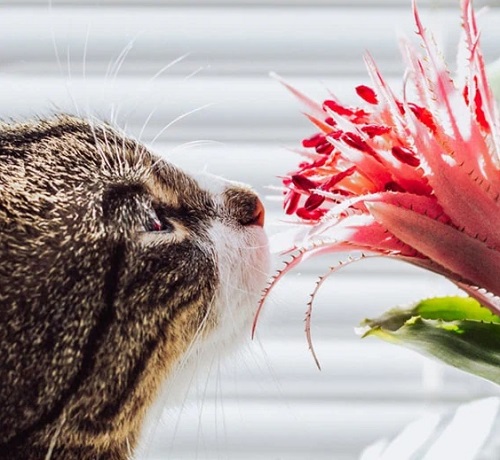
Cats chew on plants for a variety of reasons. Some experts believe it’s a way to get additional nutrients or fiber. While no single reason explains why all cats do this, several theories and factors contribute to this behavior:
- Curiosity: Cats are innately curious creatures. They often use their mouths to explore the world around them, much like how babies like to put things in their mouths to understand them.
- Dietary Needs: Some experts believe cats chew on plants to help them vomit, especially if they’ve ingested indigestible material like fur. Chewing on certain plants may induce vomiting and help them expel these materials. Additionally, some plants can provide folic acid, a vitamin essential for a cat’s well-being.
- Boredom: Cats need mental and physical stimulation. If they’re not getting enough playtime or engagement, they might turn to plants as a source of entertainment.
- Instinct: In the wild, cats consume high-fiber materials, including certain plants. Domestic cats might chew plants as an instinctual behavior, even if they don’t necessarily consume them.
- Pica: Pica is a condition where animals eat non-food items. In cats, this could manifest as a desire to eat things like plastic, fabric, or plants. The reasons for pica can be medical, dietary, or even behavioral.
- Attraction to Movement: The gentle sway of plant leaves can mimic the movement of prey, enticing cats to bite or play with them.
How to Prevent Cats from Nibbling on Plants?
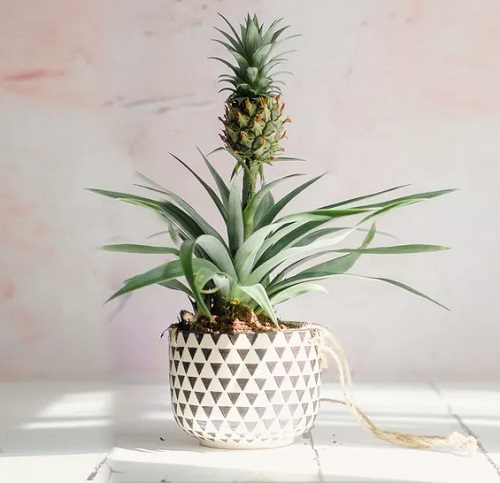
If you think your feline has a thing for your houseplants, Here’s how you can redirect that playful energy and protect both your plants and your cat:
1. Provide Cat-Friendly Plants
The simplest way to deter your cat from your prized plants is to offer them their greens.
- Cat Grass: Also known as wheatgrass, cat grass is a safe and popular choice. Cats enjoy nibbling on it, which, in turn, promotes their digestion.
- Catnip: Famous for its effect on cats, catnip can provide entertainment and satisfy their need to chew.
2. Use Toys and Puzzles
Keep your cat’s mind and body engaged with various toys and puzzles.
- Interactive Toys: Toys that move or make noise can keep your cat occupied for hours.
- Puzzle Feeders: These challenge your cat’s mind and make them work for their treats, keeping them busy and away from your plants.
3. Training and Positive Reinforcement
Teaching your cat what’s off-limits can be a gentle process.
- Training: Employ training techniques such as redirecting your cat’s attention when they approach forbidden plants. Using a calm voice to say “no,” coupled with moving them away, can help them understand the undesired action. Maintaining consistency in your guidance is crucial for the behavior to be successfully ingrained.
- Positive Reinforcement: Reward your cat with treats or affection when they choose their toys or cat-friendly plants over your houseplants.
4. Create a Cat-Friendly Space
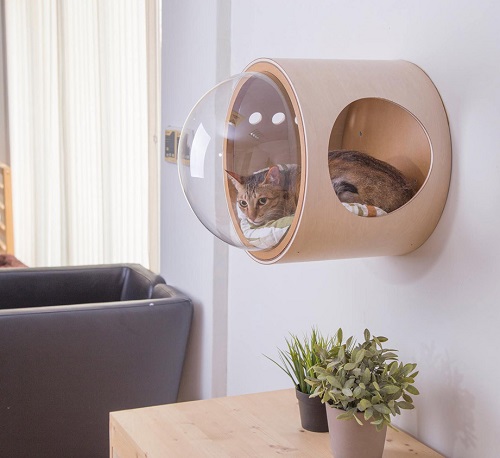
Make a dedicated area just for your cat, complete with scratching posts, beds, and their own plants.
- A Special Nook: Create a designated area that includes your cat’s favorite toys, a comfy bed, and perhaps even some catnip. This will make the space irresistibly appealing, steering your feline friend away from your houseplants.
- Window Perches: Cats love to watch the outside world. A window perch can provide endless entertainment, keeping their attention off your plants.
- Scratching Posts and Pads: Cats sometimes chew on plants as a form of exercise for their jaws or as an outlet for their scratching instincts. To redirect this behavior, offer strategically placed scratching posts and pads made from materials like sisal fabric or corrugated cardboard. These provide a satisfying texture for your cat to scratch and chew, drawing their attention away from your plants.
5. Location Considerations
Elevate your plants to areas that are less accessible to your cat, such as high shelves, wall-mounted planters, or rooms that can be secured when not in use. Utilizing these “safe zones” will minimize the chances of your cat coming into contact with your plants, especially those that are toxic or delicate.
Plants that are Poisonous to Cats

Unfortunately, not all plants are as benign as bromeliads. Many common houseplants are poisonous to cats. Therefore, it’s essential to do your research and possibly consult a veterinarian to ensure that any plants in your home are safe for your cats. Some popular Indoor Plants Poisonous to Cats include:
- Lilies: Highly toxic to cats, even in small amounts.
- Oleander: Contains cardenolides that can be fatal if ingested.
- Poinsettias: While not deadly, they can cause mouth irritation and digestive upset.
Are Bromeliads Toxic To Cats—Wrap-Up
In conclusion, your feline friend is safe around bromeliads, but it’s always wise to monitor their interactions. When keeping cats away from your plants, the key is understanding their needs and providing safe alternatives. With a blend of safe plants, engaging toys, positive reinforcement, and dedicated playtime, you can create a home where your greenery thrives and your cat stays happy and healthy.
Being informed and taking precautions can help your plants and cats flourish in the same environment. Remember, with a little care, your home can be a sanctuary for every family member.

